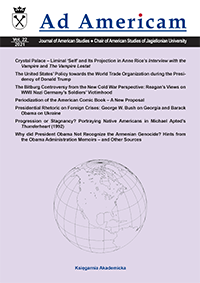Progression or Stagnancy? Portraying Native Americans in Michael Apted’s Thunderheart (1992)
Progression or Stagnancy? Portraying Native Americans in Michael Apted’s Thunderheart (1992)
Author(s): Karolina TokaSubject(s): Anthropology, Cultural Anthropology / Ethnology, Film / Cinema / Cinematography, American Literature
Published by: KSIĘGARNIA AKADEMICKA Sp. z o.o.
Keywords: Native Americans; western; revisionist western; film; American film; film studies; Indigenous studies
Summary/Abstract: As argued by Wilcomb Washburn, no other ethnic group has been misrepresented in media and popular culture to such extent as the Native Americans (2010). Movies that shaped their image did so by crystallizing stereotypes and misconceptions, through which indigenous peoples have been perceived until the present day. Thomas Edison’s vignettes, early westerns, as well as subsequent motion pictures of the 1960s and 1970s strengthened the stereotypes of the vanishing Indians, bloodthirsty savages, and their noble alter ego. The 1990s brought about a revival of the western in its new, revisionist form, mainly due to the achievements of the American Indian Movement. This paper argues that the movie Thunderheart (1992) by Michael Apted — albeit belonging to that ostensibly revolutionary current — continues to reproduce various well established stereotypes in the portrayal of the Native Americans . It examines significantachievements of this partly liberal motion picture, as well as its failures and faults. Thisarticle argues that Thunderheart departs from traditional, dualistic portrayals of Native Americans as bloodthirsty and noble savages and manages to present a revisionist version of historical events; at the same time, it fails to omit numerous Hollywood clichés, such as stereotypical representation of native spirituality, formation of an “Indian identity”, and “othering” of the Native Americans, which contributes to their further alienation and cultural appropriation. This paper provides an insightful analysis of the movie, drawing on scholarship in the field of cultural and indigenous studies in order to lay bare the ambivalence towards indigenous people in the United States, that is reflected in the movie industry. Moreover, it indicates towards the commodification of native culture, as well as the perception of Native Americans as primitive and inferior, allowing to classify Thunderheartas an unfortunate product of colonialism.
Journal: Ad Americam. Journal of American Studies
- Issue Year: 2021
- Issue No: 22
- Page Range: 87-100
- Page Count: 14
- Language: English

